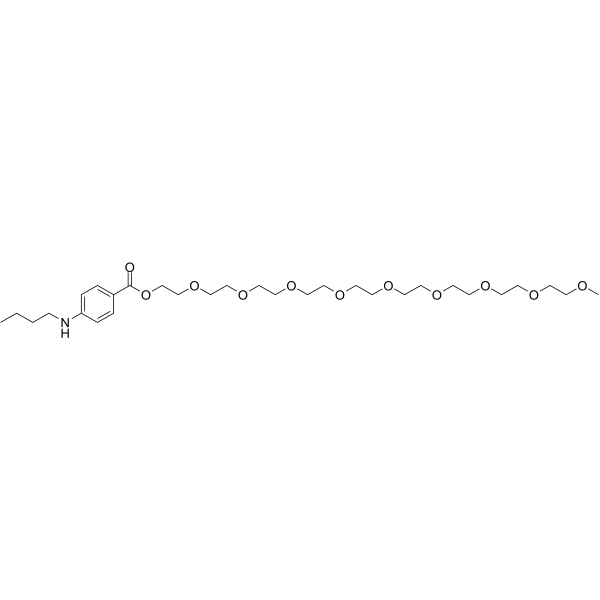CHEMICAL IDENTIFICATION
-
RTECS NUMBER :
-
DG4904500
-
CHEMICAL NAME :
-
Benzoic acid, p-(butylamino)-, 2-(2-(2-(2-(2-(2-(2-(2-(2-methoxyethoxy)ethoxy)ethoxy )ethoxy) ethoxy)ethoxy)ethoxy)ethoxy)ethyl ester
-
CAS REGISTRY NUMBER :
-
104-31-4
-
LAST UPDATED :
-
199504
-
DATA ITEMS CITED :
-
9
-
MOLECULAR FORMULA :
-
C30-H53-N-O11
-
MOLECULAR WEIGHT :
-
603.84
-
WISWESSER LINE NOTATION :
-
4MR DVO2O2O2O2O2O2O2O2O2O1
HEALTH HAZARD DATA
ACUTE TOXICITY DATA
-
TYPE OF TEST :
-
LD50 - Lethal dose, 50 percent kill
-
ROUTE OF EXPOSURE :
-
Oral
-
SPECIES OBSERVED :
-
Rodent - mouse
-
DOSE/DURATION :
-
400 mg/kg
-
TOXIC EFFECTS :
-
Details of toxic effects not reported other than lethal dose value
-
REFERENCE :
-
SMWOAS Schweizerische Medizinische Wochenschrift. (Schwabe & Co., Steintorst 13, 4010 Basel, Switzerland) V.50- 1920- Volume(issue)/page/year: 86,94,1956
-
TYPE OF TEST :
-
LD50 - Lethal dose, 50 percent kill
-
ROUTE OF EXPOSURE :
-
Subcutaneous
-
SPECIES OBSERVED :
-
Rodent - mouse
-
DOSE/DURATION :
-
100 mg/kg
-
TOXIC EFFECTS :
-
Details of toxic effects not reported other than lethal dose value
-
REFERENCE :
-
CPBTAL Chemical and Pharmaceutical Bulletin. (Japan Pub. Trading Co., USA, 1255 Howard St., San Francisco, CA 94103) V.6- 1958- Volume(issue)/page/year: 7,372,1959
-
TYPE OF TEST :
-
LD50 - Lethal dose, 50 percent kill
-
ROUTE OF EXPOSURE :
-
Intravenous
-
SPECIES OBSERVED :
-
Rodent - mouse
-
DOSE/DURATION :
-
9 mg/kg
-
TOXIC EFFECTS :
-
Details of toxic effects not reported other than lethal dose value
-
REFERENCE :
-
HPPAAL Helvetica Physiologia et Pharmacologica Acta. (Basel, Switzerland) V.1-26, 1943-68. Discontinued. Volume(issue)/page/year: 15,55,1957
-
TYPE OF TEST :
-
LD50 - Lethal dose, 50 percent kill
-
ROUTE OF EXPOSURE :
-
Subcutaneous
-
SPECIES OBSERVED :
-
Mammal - dog
-
DOSE/DURATION :
-
217 mg/kg
-
TOXIC EFFECTS :
-
Details of toxic effects not reported other than lethal dose value
-
REFERENCE :
-
NYKZAU Nippon Yakurigaku Zasshi. Japanese Journal of Pharmacology. (Nippon Yakuri Gakkai, c/o Kyoto Daigaku Igakubu Yakurigaku Kyoshitsu, Konoe-cho, Yoshida, Sakyo-ku, Kyoto 606, Japan) V.40- 1944- Volume(issue)/page/year: 54,688,1958
-
TYPE OF TEST :
-
LD50 - Lethal dose, 50 percent kill
-
ROUTE OF EXPOSURE :
-
Intravenous
-
SPECIES OBSERVED :
-
Mammal - cat
-
DOSE/DURATION :
-
4 mg/kg
-
TOXIC EFFECTS :
-
Details of toxic effects not reported other than lethal dose value
-
REFERENCE :
-
SMWOAS Schweizerische Medizinische Wochenschrift. (Schwabe & Co., Steintorst 13, 4010 Basel, Switzerland) V.50- 1920- Volume(issue)/page/year: 86,94,1956
-
TYPE OF TEST :
-
LD50 - Lethal dose, 50 percent kill
-
ROUTE OF EXPOSURE :
-
Subcutaneous
-
SPECIES OBSERVED :
-
Rodent - rabbit
-
DOSE/DURATION :
-
200 mg/kg
-
TOXIC EFFECTS :
-
Details of toxic effects not reported other than lethal dose value
-
REFERENCE :
-
SMWOAS Schweizerische Medizinische Wochenschrift. (Schwabe & Co., Steintorst 13, 4010 Basel, Switzerland) V.50- 1920- Volume(issue)/page/year: 86,94,1956
-
TYPE OF TEST :
-
LD50 - Lethal dose, 50 percent kill
-
ROUTE OF EXPOSURE :
-
Intravenous
-
SPECIES OBSERVED :
-
Rodent - rabbit
-
DOSE/DURATION :
-
5 mg/kg
-
TOXIC EFFECTS :
-
Details of toxic effects not reported other than lethal dose value
-
REFERENCE :
-
SMWOAS Schweizerische Medizinische Wochenschrift. (Schwabe & Co., Steintorst 13, 4010 Basel, Switzerland) V.50- 1920- Volume(issue)/page/year: 86,94,1956
-
TYPE OF TEST :
-
LD50 - Lethal dose, 50 percent kill
-
ROUTE OF EXPOSURE :
-
Intravenous
-
SPECIES OBSERVED :
-
Rodent - guinea pig
-
DOSE/DURATION :
-
4400 ug/kg
-
TOXIC EFFECTS :
-
Details of toxic effects not reported other than lethal dose value
-
REFERENCE :
-
ARZNAD Arzneimittel-Forschung. Drug Research. (Editio Cantor Verlag, Postfach 1255, W-7960 Aulendorf, Fed. Rep. Ger.) V.1- 1951- Volume(issue)/page/year: 7,739,1957 *** NIOSH STANDARDS DEVELOPMENT AND SURVEILLANCE DATA *** NIOSH OCCUPATIONAL EXPOSURE SURVEY DATA : NOES - National Occupational Exposure Survey (1983) NOES Hazard Code - X5770 No. of Facilities: 10 (estimated) No. of Industries: 1 No. of Occupations: 1 No. of Employees: 197 (estimated) No. of Female Employees: 59 (estimated)
|
